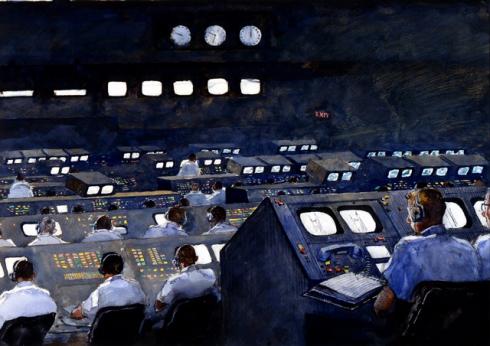
Includes Works by Goya, Rockwell, Wyeth, and Calder
More than the world's most famous flying machines now hang at the Smithsonian's National Air and Space Museum. Featuring highlights from its large but rarely seen flight-related art collection, the museum opens "Generous Friends: Building an Art Collection for the National Air and Space Museum" on Oct. 8 at its flagship building on the National Mall in Washington.
This new exhibition recognizes those who have donated works to the museum -- artists, collectors, corporations and agencies, including NASA. The collection of more than 4,000 pieces -- including those by Francisco Goya, Alexander Calder and Norman Rockwell -- provides a visual history of the people and events associated with the development of powered flight and space exploration through paintings, drawings, prints, sculptures, jewelry, ceramics and textiles.
"We are fortunate to house this remarkable collection and are grateful to those who have contributed works throughout the years. This exhibition will offer visitors inspiring, stimulating perspectives on the role powered flight has played in our lives," says General John R. Dailey, director of the National Air and Space Museum.
Works selected for the new exhibition include Rockwell's Behind Apollo 11, a Goya print from the "Los Proverbios" series, Calder's Crossroads '67 and James Wyeth's Gemini Launch Pad. Rockwell donated six works he painted for "Look" magazine to the museum. Other internationally renowned artists featured in the exhibition include Robert McCall, Keith Ferris and Robert Taylor.
Also displayed are winning entries from the museum -- art competitions held in the 1980s to increase interest in artistic exploration of aerospace themes, encourage artists working in the Washington area and to build the museum's collection.
Individual collectors have been a major source of art for the museum. A former assistant director of the museum, Frederick C. Durant III, played a significant leading role in the development of both the museum and the art collection. Harry F. Guggenheim, an aviation enthusiast and supporter of aviation technology and education, gave the museum a collection of 170 prints and broadsides, chronicling the early history of flight. In addition, Stuart Speiser, a leader in litigation involving transportation safety, gave the museum 22 commissioned paintings.
Many works in the collection were commissioned by NASA, under the direction of James Dean, then-curator of the NASA Art Program. In 1963, the agency began asking artists to travel to its various facilities to capture images of early human spaceflight. Over the years, the number of artists asked to participate grew to include Rockwell, Robert Rauschenberg, Jamie Wyeth and John McCoy. NASA transferred its early collection to the National Air and Space Museum in 1974, and continues commissioning artists today.
A total of 72 works are displayed in the exhibition, which is located in the Flight and the Arts gallery in the Mall museum building (6th and Independence, S.W.) Museum hours are 10 a.m. to 5:30 p.m. For more information, call (202) 633-1000 or visit www.nasm.si.edu.
Firing Room, Apollo 11, 17.9 x 24.9 inch watercolor on paper by James Browning "Jamie" Wyeth (July 1969).